ZEN IRODALOM ZEN LITERATURE
« Zen főoldal
« vissza a Terebess Online nyitólapjára
喝
Zen shout
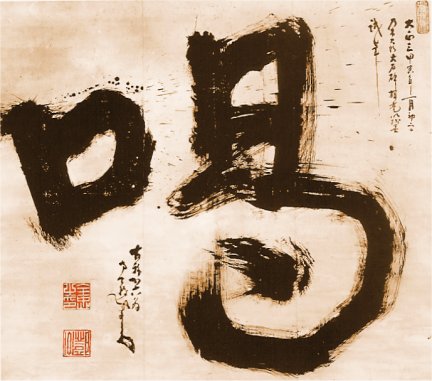
Calligraphy by 中原南天棒 Nakahara Nantenbō (1839–1925)
(Pinyin:) hè (he4)
(Wade-Giles:) ho4
(Tang dynasty
pronunciation:) khât, xat, Khaaa!
(Rōmaji:) katsu
(English:) Zen shout
(Magyar:) ho; zen ordítás
The character that represents Ma-tsu's shout. it is pronounced "Ho" in modern Chinese. T'ang pronunciation was probably "Khat". Japanese pronunciation かつ in the standard romanization is "Katsu", but the Tokyo dialect has a silent final "u" therefore "Kats'".
![]()
Katsu (Zen)
From Wikipedia, the free encyclopedia
Katsu (Japanese: 喝; Cantonese: hot3, Pinyin: hè, Wade-Giles: ho) is a shout that is described in Chán and Zen Buddhism encounter-stories, to expose the enlightened state (Japanese: satori) of the Zen-master, and/or to induce initial enlightenment experience in a student. The shout is also sometimes used in the East Asian martial arts for a variety of purposes; in this context, katsu is very similar to the shout kiai.
Etymology
The word in Chinese means literally "to yell" or "to shout". In Japanese it has also developed the meaning of "to browbeat","to scold", and "hoarse".
In the context of Chan and Zen practice, the word is not generally used in its literal meaning(s), but rather — much as with the martial arts shout of kiai — as fundamentally a means of focusing energy. When the Chan and Zen practice of the katsu first emerged in Jiangxi province in the south of Tang dynasty China in the 8th century CE, the word was pronounced roughly as /xat/, a pronunciation that is largely preserved in the Japanese on'yomi ("Sino-Japanese") reading of the character as [katsɯ̥], as well as in Cantonese and Minnan Chinese.Use
The katsu shout, insofar as it represents a kind of verbal harshness and even violence, can be considered a part of the Mahāyāna Buddhist doctrine of "skill-in-means" (Sanskrit: upāya-kauśalya), which essentially teaches that even an action or practice which seems to violate Buddhist moral guidelines—in this case, the Noble Eightfold Path's injunction against "abusive speech" —is permissible, and even desirable, so long as it is done with the aim of ultimately putting an end to suffering and introducing others to the dharma, or teachings of Buddhism.
The most celebrated and frequent practitioner of the katsu was the Chinese master Línjì Yìxuán (?–866), and many examples of his use of the shout can be found in the Línjì-lù (臨済錄; Japanese: Rinzai-roku), or Record of Linji, the collection of Linji's actions and lectures:A monk asked, "What is the basic meaning of Buddhism?" The Master gave a shout. The monk bowed low. The Master said, "This fine monk is the kind who's worth talking to!"*
The use of the katsu stands in a tradition of antinomian methods, such as striking disciples with a stick or a fly whisk, which developed within the Mǎzǔ Dàoyī (709–788) lineage. Linji greatly developed and used the katsu technique. In one of his lectures, often termed as "Linji's Four Shouts" he distinguished four different categories of katsu:
The Master said to a monk, "At times my shout is like the precious sword of the Diamond King. At times my shout is like a golden-haired lion crouching on the ground. At times my shout is like the search pole and the shadow grass. At times my shout doesn't work like a shout at all. Do you understand?" The monk started to answer, whereupon the Master gave a shout.*
* Translated by Burton Watson, The Zen Teachings of Master Lin-chi: A Translation of the Lin-chi lu, Boston, MA: Shambhala, 1993.
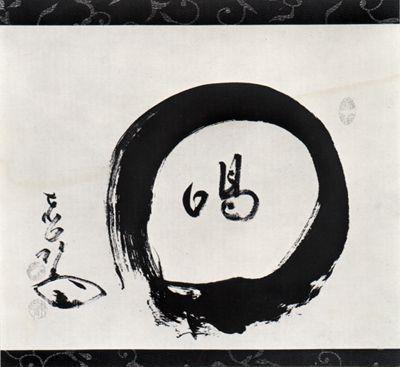
Katsu! within the enso by 東嶺圓慈 Tōrei Enji (1721–1792)

Katsu by 朝比奈宗源 Asahina Sōgen (1891-1979)
Shouting
Zen masters, especially in the Rinzai
school, characteristically make use of
powerful, sudden shouts as an expres-
sion for a state of perception beyond
analytical thought. The shout was first
used as a teaching device by the Chinese
T'ang dynasty master Ma-tsu Tao-i
(709–788) but is most closely associated
with Lin-chi I-hsuan, founder of the
Rinzai school. Zen masters may use a
loud shout to push a disciple beyond the
web of discursive and analytical
thought. In other cases, a disciple may
respond to the master with a shout to
indicate comprehension that goes
beyond words.
-------------------------------------------------------
“A shout without a single meaning, which is used by Zen masters
much in the way a stick is used. It also serves in encounters between
masters as a means of expression – transcending words and concepts
– just like a blow of a stick at the right moment can help the Zen
student achieve a breakthrough to enlightened vision. According to
tradition, such a cry was first used by the great Chinese master Ma-
tsu Tao-i, who was known for his thunderous voice. Also famous for
his skillful use of the ‘stick and shout' was Lin-chi (Jpn. / Rinzai).”
“It can also be pointed out that by no means did all Ch'an masters
of that period display a penchant for unconventional behavior. As
Venerable Yin-shun has perceptively noted, the display of such
methods as shouts and blows by individual masters is connected to
the area of China they come from. It seems that [within the Sudden
Zen School of the Sixth Patriarch Hui-Neng], masters from the
north (e.g. Lin-chi) tend to be more inclined towards ‘crude' behavior
in comparison with masters from the south (e.g. Kuei-shan). ... This
seems to imply that the iconoclastic elements found among the Ch'an
masters of the period are more a reflection of local cultural patterns
than an essential factor in their teaching.”
See Yin-shun, Chung-kuo ch'an-tsung shih
(Taipei: Cheng-wen ch'u-pan she, 1983) pp. 410-414, as quoted in
Sun-Face Buddha.
“Linji's Four Shouts” 四喝
The Record of Linji
Translation and commentary by Ruth Fuller Sasaki. Ed. by Thomas Yūhō 釈雄峯 Kirchner.
University of Hawaii Press, Honolulu, Bilingual edition, 2009.
XX
師問僧、有時一喝、如金剛王寶劍。有時一喝、如踞地金毛師
子。有時一喝、如探竿影草。有時一喝、不作一喝用。汝作麼
生會。僧擬議。師便喝。
The master asked a monk, “Sometimes a shout is like the Diamond
Sword of the Vajra King; sometimes a shout is like the golden-haired lion
crouching on the ground; sometimes a shout is like a weed-tipped fishing
pole; sometimes a shout doesn’t function as a shout. How do you understand
this?”
The monk hesitated. The master gave a shout.
xx
The master asked a monk…. The following
section has become known as
“Linji’s Four Shouts.”
The Diamond Sword of the Vajra King
is a symbol of extreme hardness and durability,
oft en used in Chan texts to indicate
the sword of wisdom that cuts off delusion.
The commentary to bl case 35, for
example, says, “If you wish to penetrate
a koan, you must be as thoroughly sharp
as the magnificent diamond sword” (t
48: 173c).
The golden-haired lion crouching on
the ground refers to a lion lying in wait for
its prey, a symbol of awesome strength and
power. Another example of this expression
is found in the verse to case 72 of the bl:
If you are a real lion with a golden mane,
how does it come that you are not crouching
on the ground? For a real lion, before
jumping on his prey, hides his fangs and
claws, draws back, and lowers his body
to the ground. And regardless of the size
of the prey he utilizes his entire power in
order to get his objective. (t 48: 200c)
Weed-tipped fishing pole. Commentators
differ widely in their interpretation of
what this is. Some take it to be a kind of
weed-trimmed pole used to probe the fish
from the bottom of the water or attract
them to one place. Others take it to be one
of two things: a pole tipped with feathers
to attract fish to a particular place, or
weeds strewn on the surface of the water
to attract fish to their shade. Whatever the
exact meaning, it appears to be used here
as a metaphor for the methods of a Chan
master to test and guide his disciples.
Az illusztráció Terebess Pál munkája Leonardo da Vinci (1452-1519) két rajza felhasználásával
Illustrated by Pál Terebess using two drawings by Leonardo da Vinci (1452-1519)
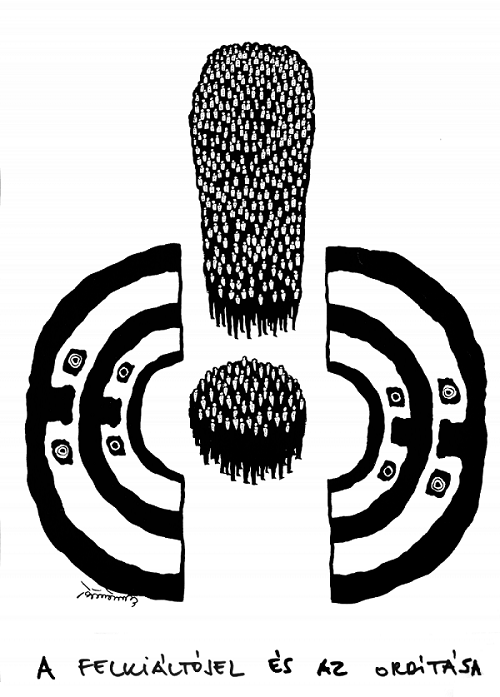
Tettamanti Béla (1946-2020) rajza
"The exclamation mark and its roar" by Béla Tettamanti (1946-2020)
Lin Chi's Four Kinds of Shouts
IN: Ch'an and Zen Teaching, Second Series,
by Lu K'uan Yü (Charles Luk)
London, Rider,
1961, pp. 96-97.
Ch'an Master I Hsuan of Lin Chi in Chen Chou District
(From The Five Lamps Meeting at the Source - Wu Teng Hui Yuan
and the Finger Pointing at the Moon - Chih Yueh Lu.)
The master said to the monk: 'Sometimes, a shout is like a precious
Vajra sword: sometimes a shout is like a lion crouching on the ground;
sometimes a shout is like a sounding rod casting its shadow upon the grass;
and sometimes a shout is not used as a shout. What will you do to
understand all this?' As the monk was 'thinking' about it, the master
shouted.*
*These are Lin Chi's four kinds of shout (kwatz in Japanese).
(1) He shouted when it was necessary to cut off his student's chain of thoughts to
disentangle the latter from all feelings and passions. In this case, his shout was likened
to a sharp diamond sword cutting down the discriminating disciple for his ultimate
resurrection as an enlightened man. (2) All wild beasts are scared of the lion, the
king of animals. Likewise, Lin Chi's shout 'scared away' all perverted views held
by his disciples in order to subdne them. (3) In order to enlighten them, Lin Chi
had to know their errors, and his shont here was to see their reactions and discover
their shortcomings before administering the right medicine and taking them back
to the correct way. His shout was likened to a rod used for 'sounding' their capacities
to absorb the truth. (4) Lastly, this shout is to awaken the fully aroused potentiality
of a disciple for his realization of self-nature and attainment of Buddhahood; it is but
a function. (5) As the monk tried to stir his mind to understand these four kinds of
shout, the master shouted to wipe out his discriminating thoughts.
The Ch'an Shout
By CH'AN MASTER CHI CH'ENG [淨因繼成 Jingyin Jicheng]*
IN: Practical Buddhism
by Lu K'uan Yü (Charles Luk)
London, Rider, 1971, pp. 39-42.
From The Imperial Selection of Ch'an Sayings [御選語錄 Yuxuan yulu]
Translated by Upasaka Lu K'uan Yü (Charles Luk)CH'AN master Chi Ch'eng and three eminent Ch'an masters,
Yuan Wu [圜悟克勤 Yuanwu Keqin, 1063–1135],
Fa Chen [法真守一 Fazhen Shouyi, 11th-12th. c.],
and Tz'u Shou [慈受懷深 Cishou Huaishen, 1077-1132],
were invited to a vegetarian dinner at governor Ch'en Liang P'i's
residence where ten learned Dharma-masters and a thousand monks
of the Ch'an Sect and of other schools were also present. Emperor
Huei Tsung [宋徽宗 Emperor Huizong, 1082-1135] of the Sung dynasty
(1101-26) availed himself of the occasion to come incognito to listen
to their discussions.*Gábor Terebess's notes
There was among the guests a Dharma-master who was well
versed in the Hua Yen (Avatamsaka) teaching and was regarded as
a skilful interpreter of (Patriarch) Hsien Shou's doctrine. Said he to
the guests: 'The Buddha set up a Dharma which consists in wiping
out gradually, from the stage of Hinayana to that of Perfect Teaching,
all concepts of is and is not to realise permanence for the
achievement of myriads of sublime virtues and the final attainment
of Buddhahood. I have heard that a mere Ch'an shout can turn
worldlings into saints; this seems to contradict the sutras and
treatises. If a shout can pass through all the five stages of our Hua Yen
School, I shall concede that it is right, otherwise it is just heresy.'All the Ch'an monks looked at Chi Ch'eng who said: 'The
Venerable Dharma-master's query does not require an answer from
the three great Ch'an masters, and though I am the youngest among
them, I shall be able to clear away his delusion.' He then called the
Dharma-master who answered: 'Yes.' Chi Ch'eng said: 'According
to the Venerable Sir's interpretation of the Hua Yen Teaching,
Hinayana deals with existence; Mahayana in its primary stage, with
non-existence; Mahayana in its final stage, with the doctrine of
neither existence nor non-existence; the Sudden School, with the
identity of existence and non-existence; and the Perfect Teaching,
with reality without existence yet existing and without nonexistence
yet non-existent. As to our sect's One Shout, it can pass
through not only these five Hua Yen stages, but also all kinds of
arts, crafts and philosophies.'He then gave a thundering shout and asked the Dharma-master:
'Did you hear?' The Dharma-master replied: 'Yes.' Chi Ch'eng
said: 'As you heard it, it stands for is and passes through the
Hinayana teaching.'A little later, he said: 'Do you hear?' The Dharma-master replied:
'I do not.' Chi Ch'eng said: 'If you do not hear, it stands for is not
and passes through the Mahayana's primary stage.'He then looked at the Dharma-master and said: 'At first, when I
gave a shout, you said you heard it, and as my voice has vanished,
you now say you do not hear it. When you say that it is not heard
now, it really was heard before and when you said that it was heard
before, it is not now. So that which neither is nor is not passes
through the Mahayana's final stage.'When I first gave a shout, its existence was not really existence
for it is its (present) non-existence that reveals its (previous) existence.
As I do not give a shout now, its non-existence is not really
non-existence for it was its (previous) existence that revealed its
(present) non-existence. This is identity of is and is not and passes
through the Sudden School.'You should know that that shout of mine is (now) not used as a
shout (1) and is beyond both is and is not. It is above all feeling and
explanation. When you speak of is, it does not set up a particle of
dust and when you speak of is not, it embraces boundless space. It
intermingles with hundreds, thousands, tens of thousands and hundreds
of thousands of shouts; hence its ability to pass through the
Perfect Teaching.'1) Cf. Ch'an and Zen Teaching, Second Series, pp. 96-7 for detailed explanation
of Lin Chi's four kinds of Shouts.Thereupon the Dharma-master rose from his seat to bow his
thanks. Chi Ch'eng continued: 'Not only can this shout pass
through the five Hua Yen stages, but even speech, silence, motion
and stillness, all time from the past to the present, boundless space
in the ten directions, the vast variety of phenomena, the six realms
of existence and four forms of birth, all Buddhas of the three times,
and Saints and Sages, the 84,000 Dharma-doors to Enlightenment,
hundreds and thousands of states of Samadhi, and countless profound
meanings, all of which accord with the noumenon and
fundamental quality, and are of the same substance as all phenomena
in the umverse; this is the Dharmakaya. As the three realms
of existence come from the Mind and all things are created by
Consciousness, the uniformity of the four seasons and of the eight
annual divisions (1) and the sameness of the positive and negative
principles are called the nature of Dharma (Dharmata). Hence the
Avatarnsaka Sutra says: "The nature of Dharma is omnipresent; the
material and the immaterial as well as sound and form are contained
in a particle of dust which comprises the four profound meanings." (2)
The unimpeded interaction of noumenon and phenomenon obtains
everywhere for they enter each other without differentiation, and
mix with each other without unity; all this is covered by this One
Shout. But this is still an expedient set up to convert people and
serves as a temporary rest, for they have not yet arrived at the
Treasure House. For you are not clear about our Patriarch's sect
which aims at Transmission from Mind to Mind, and Sealing of
Dharma by Dharma, without setting up Scriptures, for the perception
of self-nature and attainment of Buddhahood. There still is the
Upward Path' (3) which no Saints will transmit to you.'The Dharma-master asked: 'What is the Upward Path?' Chi
Ch'eng replied: 'Look down to awaken to it.' The Dharma-master1) The four seasons, two equinoxes and two solstices.
2) According to the Hua Yen Teaching, the realm of Dharma (Dharmadhatu)
comprises: (a) the phenomenal realm, with differentiation; (b) the noumenal
realm, with unity; (c) the realm of both the noumenal and phenomenal which
are interdependent; and (d) the realm of phenomena which are also interdependent.3) The Upward Path is the Transcendental Path. To look up and down is a
Ch'an idiom. To look down is to look into externals which spring from the
mind and trace them back to their source for realisation of self-mind and
perception of self-nature. To look up is to look into the Absolute which is
inexpressible and beyond the comprehension of worldlings. It is, therefore,
futile to teach the Absolute which is indescribable and can be realised only by
personal experience; hence Chi Ch'eng says: 'No Saints will transmit it to
you' and 'I shall never disclose it to you'.asked: 'What is the Treasure House?' Chi Ch'eng replied: 'This
state is beyond your reach.' The Dharma-master said: 'May the
Venerable Ch'an Master be compassionate enough to reveal it to
me.' Chi Ch' eng replied:'Even the ocean may undergo a change
But I shall never disclose it to you.'The Dharma-master was speechless and then left. The emperor
was greatly pleased with Chi Ch'eng's erudition which was
admired by all those present.
淨因繼成禪師
大日本續藏經 Dai Nihon Zokuzōkyō. (Kyoto: Zokyō shuin, 1905-1912) 119: 357-809.師同圓悟.法真.慈受并十大法師.禪講千僧。赴太尉陳公良弼府齋。時徽宗私幸觀 之。有善華嚴者。賢首宗之義虎也。對眾問曰。吾佛設教。自小乘至於圓頓。掃除空 有。獨證真常。然後萬德莊嚴。方名為佛。常聞禪宗一喝。能轉凡成聖。與諸經論似 相違背。今一喝若能入吾宗五教。是為正說。若不能入。是為邪說。 諸禪視師。師 曰。如法師所問。不足三大禪師之酬。淨因小長老可以使法師無惑也。師召善。善應 諾。 師曰。法師所謂小乘教者。乃有義也。大乘始教者。乃空義也。大乘終教者。 乃不有不空義也。大乘頓教者。乃即有即空義也。一乘圓教者。乃不有而有。不空而 空義也。如我一喝。非惟能入五教。至於工巧伎藝。諸子百家。悉皆能入。 師震聲 喝一喝。問善曰。聞麼。 曰。聞。 師曰。汝既聞。此一喝是有。能入小乘教。 須臾又問善曰。聞麼。 曰。不聞。 師曰。汝既不聞。適來一喝是無。能入始教。 遂顧善曰。我初一喝。汝既道有。喝久聲消。汝復道無。道無。則原初實有。道有。 則而今實無。不有不無。能入終教。我有一喝之時。有非是有。因無故有。無一喝之 時。無非是無。因有故無。即有即無。能入頓教。須知我此一喝不作一喝用。有無不 及。情解俱忘。道有之時。纖塵不立。道無之時。橫徧虗空。即此一喝入百千萬億 喝。百千萬億喝入此一喝。是故能入圓教。善乃起再拜。 師復謂曰。非唯一喝為 然。乃至一語一默。一動一靜。從古至今。十方虗空。萬象森羅。六趣四生。三世諸 佛。一切聖賢。八萬四千法門。百千三昧。無量妙義。契理契機。與天地萬物一體。 謂之法身。三界惟心。萬法惟識。四時八節。陰陽一致。謂之法性。是故華嚴經云。 法性徧在一切處。有相無相。一聲一色。全在一塵中。含四義。事理無邊。周徧無 餘。參而不雜。混而不一。於此一喝中皆悉具足。猶是建化門庭。隨機方便。謂之小 歇場。未至寶所。殊不知吾祖師門下。以心傳心。以法印法。不立文字。見性成佛。 有千聖不傳底向上一路在。 善又問曰。如何是向上一路。 師曰。汝且向下會 236 取。 善曰。如何是寶所。 師曰。非汝境界。 善曰。望禪師慈悲。 師曰。任從 滄海變。終不為君通。善膠口而出。上大悅。聞者靡不歎仰。
![]()
Les quatre khâts de Lin-tsi
Les Entretiens de Lin-tsi
Traduit du chinois et commentés par Paul Demiéville
Paris, Fayard, 1972
« Le maître étant monté en salle, un moine demanda quelle était la grande idée du bouddhisme. Le maître leva son chasse-mouches. Le moine fit khât. Le maître le battit. » (Entretiens, p. 37).
(Voici donc les quatre khâts de Lin-tsi (Entretiens, p. 195, § 61)
« Le maître demanda à moine : Parfois un khât est comme l'épée précieuse du roi-diamant. (Allusion au sutra du Diamant coupeur. Ce khât correspond au discours psychanalytique, des quatre discours) ; parfois un khât est comme un lion aux poils d'or tapi sur le sol (ce khât correspond au discours du maître) ; parfois un khât est comme un perche à explorer, munie d'herbes qui font ombre (ce khât correspond au discours universitaire) ; parfois un khât ne fait pas office de khât (ce khât correspond au discours hystérique). Comment comprenez-vous cela ? demanda Lin tsi. Le moine hésita. Le maître le bâtit. »
Khât (kh comme dans l'allemand ach, et à la finale un t implosif, prononciation T'ang du caractère qui se lit aujourd'hui ho) : c'est une éructation, procédé inimitable de la maïeutique Tch'an.
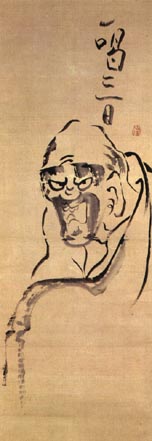
![]()
Sengai Gibon (1750-1837) tusfestménye
一喝三日
„Egy ordítás, három nap”
Terebess Gábor fordítása
Vö.: Folyik a híd, Officina Nova, Budapest, 1990, 21, 73. oldal
– Milyen eszmékre tanítod majd az embereket? – kérdezte Ma-cu Paj-csangtól.
Paj-csang szó nélkül feltartotta a légycsapóját.
– Ez minden?
Paj-csang földhöz vágta a légycsapót.
Ma-cu erre akkorát ordított, hogy Paj-csang három napra belesüketült.
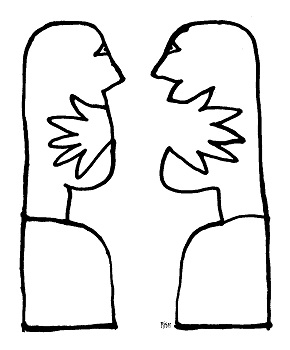
Réber László (1920-2001) rajza
Élet és irodalom, 1971. június 26. XV. évf., 26. szám
Lin-csi megkérdezte Lo-put [Lo-pu Jüan-an, 834-898]:
– Régen az egyik mester a botot szorgalmazta, a másik az ordítást. Ki volt közelebb az igazsághoz?
– Egyik sem.
– Akkor mi van közel hozzá?
Lo-pu elordította magát, a mester pedig megbotozta.
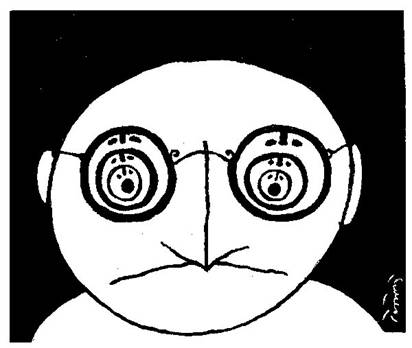
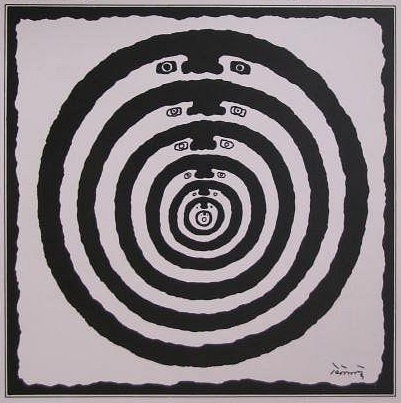
Tettamanti Béla (1946-2020) két rajza
Lin-csi megkérdezett egy szerzetest:
– Néha olyan az ordítás, mint a Mennykő király drága kardja. Néha olyan, mint a földre lapuló aranyszőrű oroszlán. Néha olyan, mint a halcsali fűcsomó árnyéka. Néha olyan, mintha nem is ordítás lenne. Honnan tudod, hogy melyiket kell használni?
A szerzetes tétovázott. A mester elordította magát.
Miklós Pál fordításában:
Vö. Kapujanincs átjáró, Helikon Kiadó, 1987, 31. oldalA Mester így szólt egyik szerzeteséhez: - Egyetlen kha* olykor olyan, mint a gyémánt-király drága kardja; egyetlen kha olykor olyan, mint egy földre kushadó aranyszőrű oroszlán; egyetlen kha olykor olyan, mint a füvekkel álcázott halászszigony; olykor pedig a kha nem ér egyetlen khát sem. Érted te ezt?
A szerzetes tétovázott, mire a Mester megverte [sic!**].*„khát horkantott – Az indulatszó, illetve hangutánzó szó (mai kínai kiejtés [pinyin átírással:] he), formula a helytelenítésre, a kérdés vagy hibás válasz elutasítására." (Miklós Pál jegyzete)
„khát horkantott" helyett pontosabb: khat-ot ordított rá vagy bömbölt egy khat-ot. A szóvégi t, bár implozív, nem hagyható el! A kh kiejtése, mint a magyar doh szóban a h. Tang-kori olvasata: Hat! (khât), mai kiejtése: Ho!
Ma-cu használta először (Ma-cu akkorát ordított, hogy Paj-csang három napra belesüketült!), majd Lin-csi tette híressé. (Terebess Gábor jegyzete)**Demiéville hibás francia fordításából « Le maître le battit. » magyarította Miklós Pál! Úgy tűnik nem ment vissza az eredeti kínaihoz, ami „elordította magát". (Terebess Gábor jegyzete)